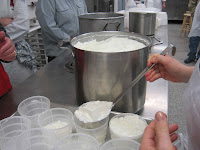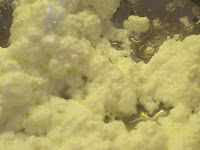 Yesterday, I took the most wonderful all-day class at L’Academie de Cuisine. The class was held at the really nice L’Academie facility in Gaithersburg – the one where the professional classes are held. It’s not the Top Chef kitchen, but it’s much more modern than the little Bethesda school.
Yesterday, I took the most wonderful all-day class at L’Academie de Cuisine. The class was held at the really nice L’Academie facility in Gaithersburg – the one where the professional classes are held. It’s not the Top Chef kitchen, but it’s much more modern than the little Bethesda school.
My friend Eris and I have been talking about cheesemaking for a couple of years and I was so glad we could go together. By the end of the day, I could almost hear her brain whirring with thoughts! She and her husband and brother-in-law run Normans Farm Market, a wonderful group of farmstands and a fantastic CSA, in Bethesda, Potomac and Chevy Chase. After our class, I won’t be at all surprised to see hand-crafted cheeses at the farmstand in a year or two. Not that I wasn’t making all sorts of plans myself — really, honey, we’d just need to build a cheese cave and a stainless steel kitchen.
Not that I wasn’t making all sorts of plans myself — really, honey, we’d just need to build a cheese cave and a stainless steel kitchen.
But I’m getting ahead of myself. The class was taught by cheesemakers Larry and Linda Faillace of Three Shepherds Farm. It was an ambitious lesson plan to make several types of cow’s milk cheeses in a little over six hours, but we were ready. Promoted as a participation class, it actually was more demonstration, with occasional moments of student stirring. A little frustrating, but now I just want to take the three day artisanal cheesemaking workshop offered at the Farm. Much more hands on.
The class was taught by cheesemakers Larry and Linda Faillace of Three Shepherds Farm. It was an ambitious lesson plan to make several types of cow’s milk cheeses in a little over six hours, but we were ready. Promoted as a participation class, it actually was more demonstration, with occasional moments of student stirring. A little frustrating, but now I just want to take the three day artisanal cheesemaking workshop offered at the Farm. Much more hands on.
We learned to make a soft, rennet-assisted, ripened cheese. Three Shepherds Farm makes a version called Cosmos. Obviously, we didn’t have the time to ripen the cheese in class, but we did see the first stage, adding a culture (in this case, a mesophilic starter, but at home, substitute buttermilk, with active cultures), and then the second stage, several hours later, adding the rennet. After some time separating curds from whey, then poured into straining/shaping baskets, the cheese is then turned several times and salted and left to ripen several days. Interestingly, the same recipe makes Quark, if treated just a little differently. Larry took the curds, and poured them into a canvas bag to drain for a couple of hours. Then whipped the cheese for about a minute in the mixer and served with maple syrup. Wow, was this an amazing alternative to yogurt or even whipped cream. I’d never had it before, but I’m ready to start making it.
Interestingly, the same recipe makes Quark, if treated just a little differently. Larry took the curds, and poured them into a canvas bag to drain for a couple of hours. Then whipped the cheese for about a minute in the mixer and served with maple syrup. Wow, was this an amazing alternative to yogurt or even whipped cream. I’d never had it before, but I’m ready to start making it. Linda was very entertaining, taking over here and there, when Larry would get all science-y – he is a PhD guy, after all. Linda is a warm, wonderful, woman. You want to hang out in her kitchen. After she tells you their story, you want to give her a hug.
Linda was very entertaining, taking over here and there, when Larry would get all science-y – he is a PhD guy, after all. Linda is a warm, wonderful, woman. You want to hang out in her kitchen. After she tells you their story, you want to give her a hug.
(the following could be slightly misremembered in places) Linda related their story – the early years in Europe with three young kids, Larry a post-doc in England studying animal genetics (I think – sorry if I’m wrong, Larry!) They travelled about, wondering what they might do next with their life. The decided to bring Fresian Sheep – beautiful animals – to the US, to raise on their farm in Vermont. Then, to make sheeps milk cheeses. The three children agreed to become shepherd, milkmaid and cheesemaker – this at ages 8, 9, 11.
They brought some Netherlands sheep to Vermont, bred them and had a nice little business when Mad Cow became a big scare. The (idiots at) USDA declared the sheep could have Mad Cow (it’s never crossed from bovine to sheep,) and in a moment of sheer bravado, siezed the sheep and slaughtered the entire flock. More than 40 armed USDA agents came to their farm.
We sat in stunned silence listening to the Three Shepherds story.
Linda, clearly one to make lemonade when given a pile of lemons, wrote a book about the whole shebang – Mad Sheep – and is now writing the optioned screenplay! Wow! Everyone was so pleased to hear there was good news after that bleak story. (And, all three kids got into college w/scholarships, perhaps due to the strength of their essays?)
So, while we listened to the stories, we watched as Larry made Quark, Feta and Ricotta. We were fed a terrific L’Academie lunch of roast chicken, blanquette de veau, salad, rice and bread pudding. Marvelous, really. We tasted raw milk (loved the flavor and mouth feel.) We talked politics of food. Learned about curds, how to cut curds into different sizes, how to drain, salt and age cheeses. It was utterly inspirational.
I really could see taking this on. Learning more. Setting up a little cottage business when we retire and move out of the big city.
We also made Feta, which Three Shepherds sells as is, and also ripens into a cheese called King Louis. And finally we made Ricotta. I came right home and made a batch, and it’s a breeze. So easy. And incredibly creamy. About 40 minutes active time. Homemade is just too good to ever ever eat store-bought again. So make it today. And then fill some manicotti or cannoli and congratulate yourself for being brilliant.
Homemade Ricotta
Note: You really do need a thermometer to make this well.
1 gallon milk – fresh, fresh, fresh, raw milk or organic, pasteurized fresh milk (not UHT) Did I mention fresh?
5 T white vinegar
1 tsp salt
Make sure all your tools are super clean and ready to go.
You’ll want a heavy bottomed large saucepan or stockpot, a stainless steel straining paddle or slotted spoon, thermometer, cheesecloth lined sieve and a bowl in which the sieve fits, if you wish to capture the whey.
Add the vinegar and salt to the milk. Heat the milk to 190•F.
While warming, keep stirring occasionally using the straining spoon/paddle. Leaving the paddle in the mixture, touching the bottom of the pan, will help heat conduct through the milk. Stir well and slowly, very gently, to avoid burning on the bottom.
Take your time – it really won’t take long.
When the cheese has reached 190•F, you start to see the yellow-white whey coming to the surface, take the ricotta off the heat, stir once or twice, and let it rest and develop for five minutes. Spoon the drained ricotta into a cheesecloth lined sieve. Be super gentle. Collecting the whey in a bowl under the sieve, if you wish. (Incidentally, whey can be used in bread baking, as a soup base, and more. Linda reports it’s quite effective at removing skunk smell from enthusiastic black labs.)
Spoon the drained ricotta into a cheesecloth lined sieve. Be super gentle. Collecting the whey in a bowl under the sieve, if you wish. (Incidentally, whey can be used in bread baking, as a soup base, and more. Linda reports it’s quite effective at removing skunk smell from enthusiastic black labs.)
Ok. That’s it. You have ricotta. Now, mix in some parmesian, chopped spinach sauteed with onion, garlic and a touch of nutmeg. Fill some crespelle, or manicotti. Pour marinara sauce over it all. Bake it til warmed through. Hug yourself and tell yourself you are incredibly clever.
 A little extra cheesy goodness.
A little extra cheesy goodness.
After six hours of non-stop learning, we tasted this lovely plate of cheeses, some from Three Shepherds Farm and some from other places. In this tasting, we ran the gamut from soft to hard cheese, delicate to strong. Read the cheeses as though the plate were a clock, and the first cheese starts at 12 o’clock.
St. Andre, France, triple creme
Lake’s Edge, a Vermont ashed goat, like Morbier
Three Shepherds Farm (TSF) Cosmos, soft ripened cheese, coated in herbs and Anahiem pepper
TSF Aurora (Yum)
Cabot Clothbound Cheddar
Kaltbach, Switzerland, a cave aged gruyere
Jasper Hill Bailey Hazen Blue, VT
TSF Blue
TSF Montagne (tasty, but a little salty)
Gjetost, Norway
in the center – ricotta.
up in the left hand corner – quark















Olga Norstrom
Wow! Sounds amazing! They sound like fantastic teachers! I took a cheesemaking class taught be Geri Saada at Brookdale Community college in Middletown NJ. She was very good. In it, I learned mozarella, ricotta, queso blanco, mascarpone and creme fraiche, and once I understood those basics, I was able to figure out how to do other soft cheeses and cultured dairy items like kefir, sour cream, etc., on my own…well, with the help of a few good books and websites. The home-made versions taste so much better than store-bought, right? What I'd like to learn next are hard cheeses. Have you learned that yet?
MrsWheelbarrow
Hi Olga – Thanks for the comment. Homemade is the way to go. They're really amazingly different. No, I haven't learned hard cheeses. This class just introduced me to some of what you learned. I'm so excited to explore this world of cheesemaking. I want to do mozzerella next.